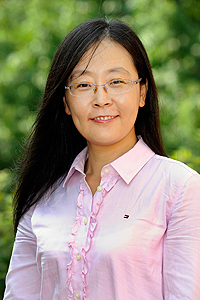NIEHS research featured in The Journal of Immunology
By Robin Arnette

Gao’s medical background makes her well-suited for studying neurodegenerative illnesses. (Photo courtesy of Steve McCaw)

Hong said that prior to his group’s results, most researchers usually thought that Mac-1 only interacted with a variety of bacteria. (Photo courtesy of Steve McCaw)
When pathogens attack the human body, its immune system mounts an aggressive defense by sending highly specialized cells, called macrophages that recognize, bind, and ingest the infectious agents. One of the proteins involved in this molecular battle is macrophage-1 Ag (Mac-1), a receptor that appears on the surface of many types of immune cells, including macrophages. Previous studies have determined that Mac-1 recognizes a number of molecules associated with pathogen invasion or tissue damage, for example, endotoxin from gram negative bacteria and aggregated proteins, but its role in virus infection was largely unknown.
Now, NIEHS scientists have found that Mac-1 also interacts with double-stranded RNA (dsRNA), the byproduct of a viral infection. After viral dsRNA spills out of a dying immune cell and enters the extracellular space, Mac-1 intercepts it and mediates host immune responses. The Journal of Immunology published the findings Jan. 1 and featured the research in its “In This Issue” section, a highlight of the top 10 percent of articles published in the journal.
Huiming Gao, M.D., Ph.D., is corresponding author on the paper and a research fellow in the NIEHS Neuropharmacology Group, headed by Jau-Shyong Hong, Ph.D. She said this paper distinguishes itself from other viral studies because it identifies Mac-1 as a novel receptor for dsRNA and uncovers a distinct downstream signaling pathway that is independent of dsRNA’s known receptor, Toll-like receptor 3.
“In the virus field, many scientists study how the virus enters the cell or how it replicates inside the host cell,” Gao said, “but, for our work, we examined how the viral product, released from broken host cells, triggers the host’s fight against the infection.”
Targeting neurodegenerative diseases
The analysis that Hong and his group performed expands scientists’ understanding of this important receptor and may lead to discovery of a therapeutic target for viral-induced illnesses. The Neuropharmacology Group focuses on neurodegenerative diseases, and Hong said a growing amount of evidence proposes that viruses, one of many environmental determinants, are important risk factors for chronic neuroinflammatory brain diseases, such as Parkinson’s disease.
“If we are able to modulate the degree of inflammation in the brain by targeting the Mac-1 pathway, it may help the survival of neurons,” Hong said.
Parkinson’s disease isn’t the only viral condition that Hong’s group has in its crosshairs. Ross River virus, (http://www.public.health.wa.gov.au/2/486/2/ross_river_virus_fact_sheet.pm) mainly found in Western Australia and several South Pacific islands, is transmitted by mosquitoes and causes joint inflammation and muscle degeneration. Understanding how Mac-1 stimulates the host immune response could lead to relief for this malady, too.
For future studies, paper first author Hui Zhou, Ph.D., and others at NIEHS will use brain macrophage-like immune cells, called microglia, to study how the interaction of viral dsRNA and microglial Mac-1 affects neuronal survival in Parkinson’s disease. The work could lead to advances in conditions as varied as Huntington’s disease, Alzheimer’s disease, and multiple sclerosis.
Citation: Zhou H, Liao J, Aloor J, Nie H, Wilson BC, Fessler MB, Gao HM, Hong JS. (http://www.ncbi.nlm.nih.gov/pubmed/23209319) 2013. CD11b/CD18 (Mac-1) is a novel surface receptor for extracellular double-stranded RNA to mediate cellular inflammatory responses. J Immunol 190(1):115-125.
"Uncovering the genetic component ..." - previous story ![]()
![]() next story - "This month in EHP ..."
next story - "This month in EHP ..."
February 2013 Cover Page


